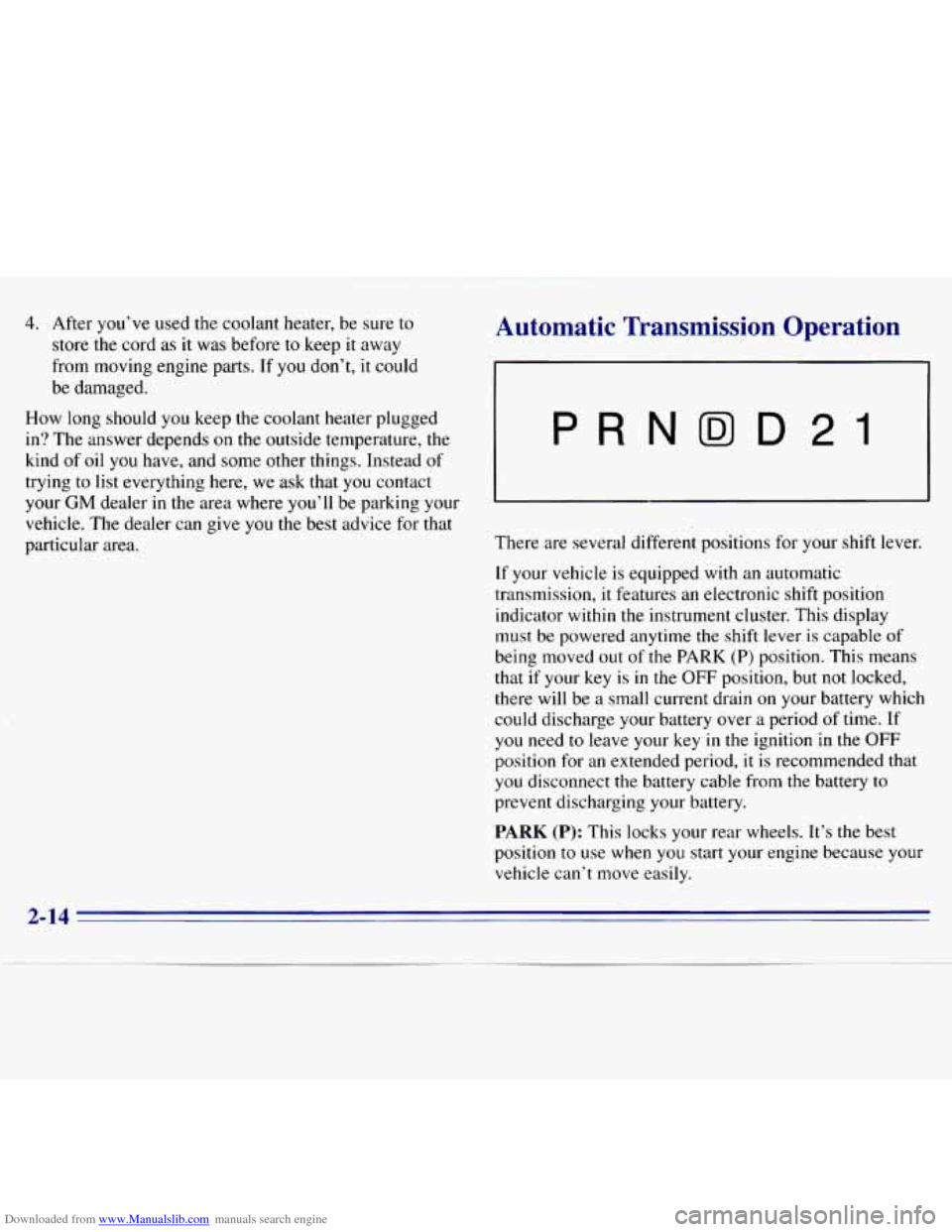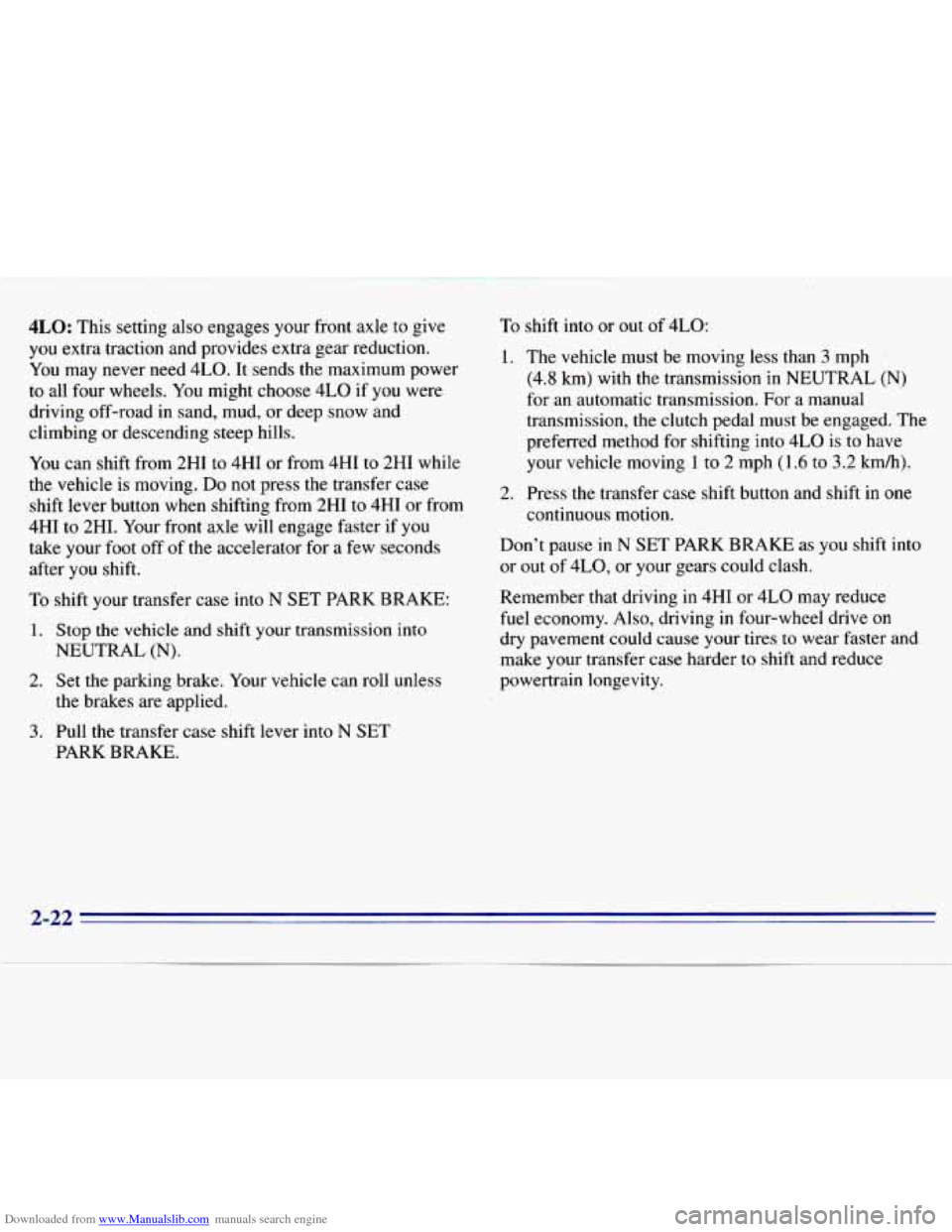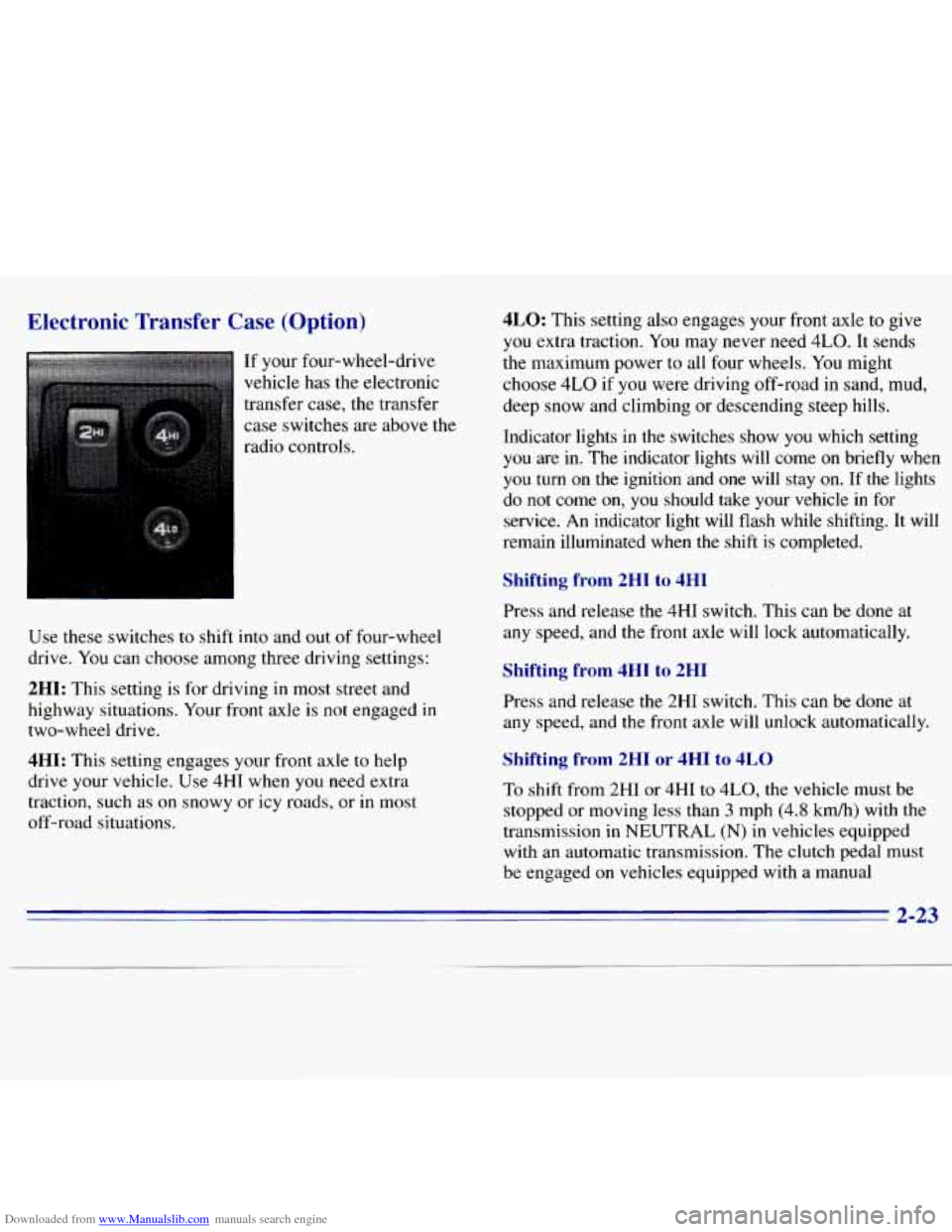Page 10 of 375
Downloaded from www.Manualslib.com manuals search engine 1
Vehicle Symbols
These are some of the symbols you may find on your vehicle.
For example,
these symbols
are used on an
original battery:
POSSIBLE A
CAUTION
INJURY
PROTECT EYES BY
SHIELDING
CAUSTIC
BURNS
SPARK
OR ,111,
COULD FLAME
EXPLODE BATTERY
These symbols are important
for you and
your passengers
whenever your vehicle
is
driven:
DOOR LOCK
UNLOCK
FASTEN SEAT
BELTS
POWER
WINDOW
These symbols have
to do with
your lights:
SIGNALS e
TURN
RUNNING
* 0
DAYTIME -
LAMPS '.*
FOG LAMPS $0
These symbols
are on some
of
your controls:
WINDSHIELD
WIPER
WINDSHIELD DEFROSTER
VENTILATING FAN
These symbols are used on
warning and
indicator lights:
COOLANT -
TEMP -
CHARGING I-1
BATTERY
SYSTEM
BRAKE
(0)
COOLANT a
ENGINE PRESSURE OIL e,
ANTI-LOCK (@)
BRAKES
Here are some
other symbols
you may see:
FUSE
LIGHTER
m
HORN k3
SPEAKER
b
FUEL B3
V
Page 52 of 375
Downloaded from www.Manualslib.com manuals search engine Section 2 Features and Controls
Here you can learn about the many standard and
optional features on
your vehicle, and information on
starting, shifting and braking. Also explained are the
instrument panel and the warning systems
that tell you if
everything is working properly -- and what to do if you
have a problem.
K -1s
I A CAUT'3N:
Leaving young children in a vehicle with the
ignition key
is dangerous for many reasons. A chilc
or others could be badly injured or even killed.
They could operate power windows or other
controls or even make the vehicle move. Don't
leave the keys in
a vehicle with young children.
2-1
Page 55 of 375
Downloaded from www.Manualslib.com manuals search engine Your vehicle may be equipped with a side access
panel for convenience in loading and unloading cargo.
It is recommended that passengers who sit in the rear
jump seat enter and exit through
the door on the
passenger's side.
To open the side access panel, first open the driver's
front door.
Then, use the handle on the panel to open it.
You must close the side access panel before you can
close the driver's door.
Power Door Locks
If your vehicle has power
door locks, the switch is
located
on the armrest.
Press
LOCK to lock all the
doors at once.
To unlock
the doors, press the raised area next to the
key symbol.
Leaving Your Vehicle
If you are leaving the vehicle, take your keys, open your
door and set
the locks from inside. Then get out and
close the door.
2-4
Page 65 of 375

Downloaded from www.Manualslib.com manuals search engine 4. After you’ve used the coolant heater, be sure to
store the cord as it was before
to keep it away
from moving engine parts. If you don’t,
it could
be damaged.
How long should you keep the coolant heater plugged
in? The answer depends
on the outside temperature, the
kind
of oil you have, and so.me other things. Instead of
trying to list everything here, we ask that
you contact
your
GM dealer in the area where you’ll be parking your
vehicle. The dealer can give you the best advice for that
particular area.
Automatic Transmission Operation
. --
P RNDD 21
There are several different positions for your shift lever.
If your vehicle is equipped with an automatic
transmission, it features an electronic shift position
indicator within the instrument cluster. This display
must be powered anytime
the shift lever is capable of
being moved out of the PARK (P) position. This means
that
if your key is in the OFF position, but not locked,
there will be a small current drain on your battery which
could discharge your battery over a period
of time. If
you need to leave your key in the ignition in the OFF
position for an extended period, it is recommended that
you disconnect the battery cable from the battery to
prevent discharging your battery.
PARK (P): This locks your rear wheels. It’s the best
position
to use when you start your engine because your
vehicle can’t move easily.
2-14
Page 68 of 375
Downloaded from www.Manualslib.com manuals search engine FIRST (1): This position gives you even more power
(but lower fuel economy) than
SECOND (2). You can
use it on very steep hills, or in deep snow or mud. If the
selector lever
is put in FIRST (1) while the vehicle is
moving forward, the transmission won’t shift into
FIRST (1) until the vehicle is going slowly enough.
1 NOTICE:
If your rear wheels can’t rotate, don’t try to
drive. This might happen if you were stuck in
very deep sand or mud or were up against
a solid
object.
You could damage your transmission.
Also, if you stop when going uphill, don’t hold
your vehicle there with only the accelerator pedal.
This could overheat and damage the transmission.
Use your brakes or shift into
PARK (P) to hold
your vehicle in position on a hill.
Manual Transmission
5-Speed
This is your shift pattern.
2-17
Page 71 of 375
Downloaded from www.Manualslib.com manuals search engine Four-wheel Drive (Option)
If your vehicle has four-wheel drive, you can send your
engine’s driving power to all four wheels for extra
traction.
To shift out of two-wheel drive and into
four-wheel drive, move the transfer case shift lever to
4HI or 4LO. You should use 2HI for most normal
driving conditions.
NOTICE:
Driving in the 4HI or 4LO positions for a long
time on dry or wet pavement could shorten the life of your vehicle’s drivetrain.
Manual Transfer Case
If your four-wheel-drive vehicle has the manual transfer
case, the transfer case shift lever is on the floor next
to
the driver. Use this lever to shift into and out of
four-wheel drive.
2-20
Page 73 of 375

Downloaded from www.Manualslib.com manuals search engine 4LO: This setting also engages your front axle to give
you extra traction and provides extra gear reduction.
You may never need 4LO. It sends the maximum power
to all four wheels. You might choose 4LO
if you were
driving off-road in sand, mud, or deep snow and
climbing or descending steep hills.
You can shift from 2HI to 4HI or from 4HI to 2HI while
the vehicle is moving.
Do not press the transfer case
shift lever button when shifting from 2HI to 4HI
or from
4HI to 2HI. Your front axle will engage faster
if you
take your foot
off of the accelerator for a few seconds
after you shift.
To shift your transfer case into
N SET PARK BRAKE:
1. Stop the vehicle and shift your transmission into
2. Set the parking brake. Your vehicle can roll unless
NEUTRAL
(N).
the brakes
are applied.
3. Pull the transfer case shift lever into N SET
PARK BRAKE.
To shift into or out of 4LO:
1. The vehicle must be moving less than 3 mph
(4.8
km) with the transmission in NEUTRAL (N)
for an automatic transmission. For a ,manual
transmission, the clutch pedal must be engaged. The
preferred method for shifting into 4LO is to have
your vehicle moving 1 to 2 mph (1.6 to 3.2 km/h).
2. Press the transfer case shift button and shift in one
continuous motion.
Don’t pause in
N SET PARK BRAKE as you shift into
or out
of 4L0, or your gears could clash.
Remember that driving in 4HI or
4LO may reduce
fuel economy. Also, driving in four-wheel drive
on
dry pavement could cause your tires to wear faster and
make your transfer case harder to shift and reduce
powertrain longevity.
2-22
Page 74 of 375

Downloaded from www.Manualslib.com manuals search engine Electronic Transfer Case (Option)
If your four-wheel-drive
vehicle has the electronic
transfer case, the transfer case switches are above the
radio controls.
Use these switches
to shift into and out of four-wheel
drive. You can choose among three driving settings:
2HI: This setting is for driving in most street and
highway situations. Your front axle is not engaged in
two-wheel drive.
4HI: This setting engages your front axle to help
drive your vehicle.
.Use 4HI when you need extra
traction, such as on snowy or icy roads, or
in most
off-road situations.
4LO: This setting also engages your front axle to give
you extra traction. You may never need
4LO. It sends
the maximum power to all four wheels.
You might
choose
4LO if you were driving off-road in sand, mud,
deep snow and climbing or descending steep hills.
Indicator lights in the switches show
you which setting
you are in. The indicator lights will come on briefly when
you turn on the ignition and one will stay on. If the lights
do
not come on, you should take your vehicle in for
service.
An indicator light will flash while shifting. It will
remain illuminated when
the shift is completed.
Shifting from 2HI to 4HI
Press and release the 4HI switch. This can be done at
any speed, and the front axle will lock automatically.
Shifting from 4HI to 2HI
Press and release the 2HI switch. This can be done at
any speed, and the front axle will unlock automatically.
Shifting from 2HI or 4HI to 4LO
To shift from 2HI or 4HI to 4L0, the vehicle must be
stopped or moving less than
3 mph (4.8 kmh) with the
transmission
in NEUTRAL (N) in vehicles equipped
with an automatic transmission. The clutch pedal
must
be engaged on vehicles equipped with a manual
2-23